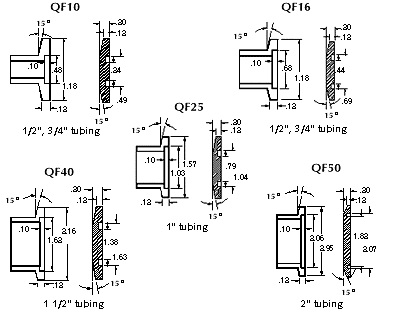 |
||||||||||
| Flanges & Components > ISO > QF Flanges > | |
Technical Notes & Dimensions | |
|
QF Flanges KJLC's QF Flanges are simple and flexible O-ring vacuum
coupling equal to the flanges known as KF (or Klein Flange) by the
International Standards Organization, and KJLC's QF flanges are also
compatible for vacuum sealing with KF flanges from European
manufacturers. An assembly consists of two identical ("sexless")
flanges, a clamp, and a centering ring to align the flanges and to
prevent the O-ring from collapsing. The thumbscrew clamp typical for
QF flanges requires no tools for assembly. The system is ideal for
small diameter tubing that needs frequent reassembly. QF fittings
work in rough or foreline vacuum plumbing and simple HV
(10-8 torr) chambers. The elastomeric O-ring limits the
connection's temperature range and ultimate vacuum. Greases & O-Rings Some
experts advise users to grease the O-ring before assembly. However,
leak-free joints depend as much on the absence of dust or lint
particles on the O-ring and imperfection on the flange surfaces as
on the presence or absence of grease. The choice between "to grease
or not to grease" probably relates to how oil-free the user wishes
the system to be. Greases, in general, have very low vapor
pressures, but any measurable vapor pressure means the grease will
(very slowly) migrate from the O-ring to other surfaces. | |
QF Flange Dimensions
| |
